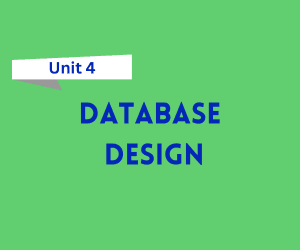
Free Download Database Design Notes in pdf – Bca 4th Semester. High quality, well-structured and Standard Notes that are easy to remember.
Click on the Download Button 👇
Database Design
Database design is the process of structuring and organizing data in a database to ensure efficient storage, retrieval, and management. It involves defining the schema, relationships, and constraints necessary to support business requirements while maintaining data integrity and minimizing redundancy. A well-designed database serves as the backbone of any data-driven application, enabling scalability, reliability, and optimal performance.
The process of database design typically includes gathering requirements, creating a conceptual model (e.g., Entity-Relationship (ER) diagrams), transitioning to a logical model (e.g., tables, keys), and finalizing a physical model that maps the database to specific storage systems.
Key Points
Importance of Database Design:
- Ensures efficient data organization and retrieval.
- Reduces redundancy, inconsistency, and errors.
- Provides a framework for scalability and future enhancements.
Steps in Database Design:
- Requirement Analysis: Understanding the purpose and scope of the database.
- Conceptual Design: Creating ER diagrams to represent entities, attributes, and relationships.
- Logical Design: Translating the conceptual model into tables, keys, and constraints.
- Normalization: Organizing data into normal forms to eliminate redundancy.
- Physical Design: Implementing the logical design on a specific DBMS platform.
Normalization:
- A systematic process to structure data into forms like 1NF, 2NF, 3NF, and BCNF.
- Ensures minimal redundancy and maintains data integrity.
Schema Design:
- Divided into conceptual schema (abstract design), logical schema (table structures), and physical schema (storage details).
Tools for Database Design:
- Tools like MySQL Workbench, PostgreSQL pgAdmin, Oracle Designer, and ER/Studio aid in creating and managing database designs.
Features of Database Design
Data Integrity:
- Enforces rules to maintain accuracy and consistency through primary keys, foreign keys, and constraints.
Scalability:
- Facilitates future growth by designing a structure that can handle increasing data volumes.
Efficiency:
- Optimizes query performance through indexing and appropriate normalization.
Data Redundancy Reduction:
- Minimizes duplicate data, improving storage efficiency and integrity.
Flexibility:
- Adapts to changes in business requirements without major redesigns.
Security and Access Control:
- Incorporates mechanisms to protect data from unauthorized access.
FAQs
Q1: What is database design?
A1: Database design is the process of creating a structured framework for storing and managing data in a database.
Q2: Why is normalization important in database design?
A2: Normalization reduces redundancy, prevents anomalies, and ensures data consistency and integrity.
Q3: What are ER diagrams?
A3: Entity-Relationship (ER) diagrams visually represent entities, their attributes, and relationships in a database.
Q4: What is the difference between logical and physical design?
A4: Logical design focuses on the structure (tables, keys), while physical design addresses how the database is implemented on storage systems.
Q5: How does indexing improve database performance?
A5: Indexing accelerates data retrieval by creating a quick lookup mechanism for specific values.
Q6: What tools are commonly used for database design?
A6: Popular tools include MySQL Workbench, Lucidchart, dbForge Studio, and Oracle SQL Developer.
Q7: Can database design be modified after implementation?
A7: Yes, but poorly designed databases can be difficult to modify, which is why thorough design is critical.
Q8: How do foreign keys maintain data integrity?
A8: Foreign keys enforce referential integrity by ensuring that relationships between tables are valid.